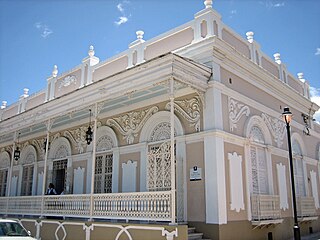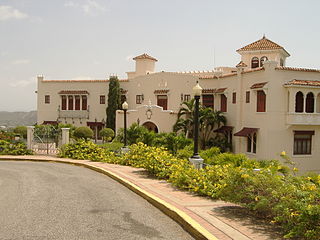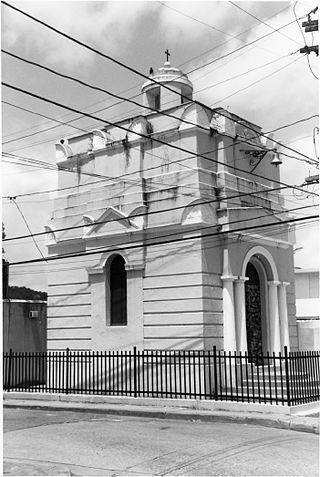
Vega Baja is a town and municipality located on the coast of north central Puerto Rico. It is north of Morovis, east of Manatí, and west of Vega Alta. Vega Baja is spread over 14 barrios. The population of the municipality was 54,414 at the 2020 census. It is part of the San Juan–Caguas–Guaynabo metropolitan statistical area.

Porta Coeli Convent church, or El Convento de Santo Domingo de Porta Coeli in Spanish, is one of the oldest church structures in the western hemisphere, located in San Germán, Puerto Rico.

Caparra is an archaeological site in the municipality of Guaynabo, Puerto Rico. It was declared a U.S. National Historic Landmark in 1994. The site contains the remains of the first Spanish capital of the island, settled in 1508 and abandoned in 1521. It represents the oldest known European settlement on United States territory.

Casa del Rey, the "King's House," is a historic place in the town of Dorado, in Puerto Rico. It is also known as Cuartel de la Guardia de Milicias, Parador, or Carcel Municipal.

The Casa Roig Museum is a historic house museum and gallery in Humacao, Puerto Rico. It was designed as a residence for the wealthy sugar planter Antonio Roig by the prominent Czech architect and Puerto Rico resident Antonin Nechodoma (1877–1928), and built in 1920.

This portion of National Register of Historic Places listings in Puerto Rico is along the north coast, north plains, and north slopes of the Cordillera, from Isabela to Guaynabo.

This is a list of properties and districts in the southern municipalities of Puerto Rico that are listed on the National Register of Historic Places. It includes places along the southern coast of the island, and on the south slope of Puerto Rico's Cordillera Central.

The San Germán Historic District is a 36-acre (15 ha) historic district located in the western section of the town of San Germán, Puerto Rico. The district was added to the National Register of Historic Places in 1994. The district contains more than 100 significant buildings, including the Church San Germán de Auxerre and the Convento de Porta Coeli.

The Panteón Nacional Román Baldorioty de Castro is a tract of land in Barrio Segundo of the city of Ponce, Puerto Rico, originally designed as the city's cemetery, but later converted into what has come to be a famous burial place. Established in 1842, it is Puerto Rico's first national pantheon. It is the only cemetery dedicated as a museum in Puerto Rico and the Caribbean. Prior to being dedicated as a Panteón Nacional, it was known as Cementerio Viejo or as Cementerio Antiguo de Ponce, and is listed under that name on the U.S. National Register of Historic Places. The Pantheon is named after Román Baldorioty de Castro, a prolific Puerto Rican politician, and firm believer of Puerto Rican autonomy and independence. His remains are located here. The Pantheon also houses a small museum about the history of autonomism in the Island, and it is currently used both as a park and a venue for the expression of culture and the arts. It is called the Museo del Autonomismo Puertorriqueño.

Casa Paoli is a historic house and biographical museum in barrio Cuarto, Ponce, Puerto Rico, in the Ponce Historic Zone. The house is significant as the birthplace of Antonio Paoli (1871–1946), a tenor who was the "first Puerto Rican to reach international recognition in the performing arts" and "one of the most outstanding opera singers of all times". The house was the childhood home of the artist and he was introduced to art and opera at this house during his formative years. In 1987, the house was turned into a museum to honor the career of Antonio Paoli. The building was listed on the U.S. National Register of Historic Places in 2009.

Casa Cautiño is a house museum in Guayama, Puerto Rico. The museum collection, administered by the Institute of Puerto Rican Culture, include works of art, wood carvings, sculptures and furniture built by Puerto Rican cabinetmakers for the Cautiño family. It's listed on the National Register of Historic Places.

Museo Castillo Serrallés, a.k.a. Museo de la Caña y el Ron, is an agricultural museum in the city of Ponce, Puerto Rico, that showcases the history of sugar cane, its derivative rum industry, and their impact in the economy of Puerto Rico. The most notorious feature of the museum is the building it occupies. The building is a large four-story structure built in the 1930s for the owner of Ponce's Destileria Serralles, one of Puerto Rico's largest rum distilleries. The distillery was once also home to Puerto Rico's largest sugar-factory called Central Mercedita, producers of the Snow White sugar brand. The building, known as Castillo Serrallés, was designed by Pedro Adolfo de Castro in 1930 in the Spanish Colonial Revival style.

The José Celso Barbosa House Museum is a historic house museum in Bayamón municipality, Puerto Rico.

Vega Baja barrio-pueblo is a barrio and downtown area that serves as the administrative center (seat) of Vega Baja, a municipality of Puerto Rico. Its population in 2010 was 816.

Aguadilla barrio-pueblo is an urban barrio and the administrative center (seat) of Aguadilla, a municipality of Puerto Rico. Its population in 2010 was 3,627.

The Guzmán Family Pantheon, also known as the Guzmán Hermitage, is a single story, lime-stuccoed, brick masonry funerary chapel located in Humacao Pueblo, in the Puerto Rican municipality of the same name. The structure was built in 1864 the Eclectic style, with Classic, Renaissance and Exotic architectural elements.

The Church Santa María del Rosario of Vega Baja is a historic Catholic parish church from 1860 located in the main public square (plaza) of Vega Baja Pueblo, the historic and cultural downtown of the municipality of Vega Baja, Puerto Rico. The parish, which is part of the Roman Catholic Diocese of Arecibo, was added to the United States National Register of Historic Places in 1984 as part of the Historic Churches of Puerto Rico thematic multiple property submission.

The Casa Portela Museum is a historic house and local history museum located in Vega Baja Pueblo, the administrative and historic center of the municipality of Vega Baja, Puerto Rico. The museum consists of a historic home locally known as the Portela House and an adjacent modern museum building located in a revitalized historic city block bordered by Hostos Street to the east, and the José Julián Acosta and Betances Streets to the north and south, respectively.























